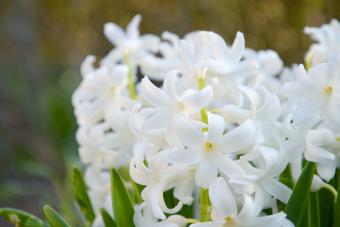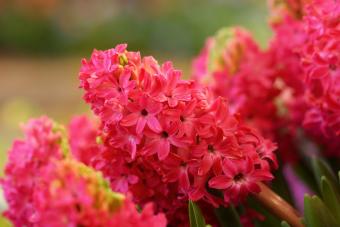
Hyacinths are stunning, fragrant additions to the spring garden, just as perfect in a garden bed as they are in a bouquet. Even better, they're very easy to grow and they're available in a range of colors from soft pastels to deep, nearly black shades.

charliepix/ iStock / Getty Images Plus/ Modified by LoveToKnow Pink, white and purple hyacinth
Growing Hyacinths in Your Garden
Hyacinth is a bulb two to three inches in diameter. The flower stalk is usually about seven to ten inches long and closely packed with single or double flowers, each about an inch long. There are often as many as 100 flowers on the flower spike. Cultivars have been developed that bloom in a wide range of colors. The leaves are bright green, lance-shaped, and may grow up to 14 inches long. Hyacinths are intensely fragrant.
Where to Plant Hyacinths: Light and Soil Requirements
Hyacinths do best in full sun, although they also grow in shade. Any moderately fertile soil with good drainage is fine.
Plant bulbs in the autumn, about a month before the ground freezes so that roots have a chance to develop. Bulbs should be planted more than three inches apart and four to six inches deep. Hyacinths require a cold dormant period in order to bloom.
Watering and Fertilizing
Spread fertilizer on top of the soil in spring and scratch in lightly in early spring or late fall. You could also topdress the area with compost to increase soil fertility.
Hyacinths need about an inch of water per week, so you might have to water during extended dry periods.
Pruning Hyacinths
After the plant has bloomed, cut off the flower spike but leave the leaves. The bulb will store energy for next year's bloom until the leaves wither and die back.
Hyacinth Pests and Diseases
Hyacinths are bothered by very few pest and disease problems. Even deer and rabbits don't seem interested in them.
The main issue people have when growing hyacinths is that over time, the blooms become less impressive to the point where they're downright scrawny or stop blooming at all. This is common for hyacinths, which aren't very long-lived bulbs in general. It doesn't mean you did anything wrong, it's just the way they are. The best remedy for this is to plant a few new hyacinths every fall, so that even when your older bulbs start dwindling, you'll have plenty of new, robust blooms to replace them.
Propagating Hyacinths
The most straightforward way to propagate hyacinths is to separate the little bulbils that form off of the larger, more mature bulbs, and transplant them in another spot. It might take a year or two to bloom, but eventually you'll have a new, blooming hyacinth from these bulbils.
Common Questions: Growing Hyacinths
There are a few common questions people often have about growing hyacinths. Here are some of the most frequently asked questions, as well as their answers.
Do Hyacinths Come Back Every Year?
Yes, they do… to a point. They'll return reliably for three to five years, but after that, you'll start to see decreased blooms or none at all. The best solution is to plant fresh bulbs.
What Do You Do With Hyacinth Bulbs After They Bloom?
If you grew them in the garden, simply deadhead to remove the faded bloom, but leave the foliage so the bulb can store energy for next spring. If you forced the hyacinth indoors, you can plant the bulb out in your garden in spring after your last spring frost date.

Will Hyacinth Bulbs Multiply?
Yes, they will. Hyacinth bulbs will produce "baby" bulbs, or bulbils, which will eventually grow to produce their own foliage and blooms. It will be several years before the offset is mature enough to bloom.
Beautiful Hyacinths to Grow in Your Garden
There are over 2,000 named cultivars of hyacinths, making the selection available truly staggering. However, only a handful of traditional favorites are usually available in garden centers and nurseries. For more rare or unique varieties, you'll have to find a mail-order source.
White Hyacinth Varieties
These white-blooming varieties would be perfect for brightening up a darker corner of the garden. Consider planting some in a vibrant glazed pottery container for a fresh, clean spring look.

- 'Carnegie' produces pristine white blooms and grows to about 10 inches tall. It blooms in early to mid spring.
- `Edelweiss' is a taller-growing white hyacinth, growing to around eight to 11 inches tall.
- 'L'Innocence' is an heirloom hyacinth that's been a favorite of gardeners for around 150 years. Its blooms are a warm white tone, and it grows to about a foot tall, making this one of the taller options for hyacinth growers.
Pink Hyacinth Varieties
Whether you prefer pale, baby pinks, vibrant salmons, or deep mauves, there is a type of hyacinth that you're sure to love. Consider growing a few of these varieties in different tones and sizes to have a gorgeous mass of pink blooms in mid-spring.

- 'Anne Marie' has gorgeous cotton candy pink blooms and a strong fragrance. It blooms in mid-spring and grows to around 12 inches tall.
- `Pink Pearl' produces bright, vibrant fuscia-pink flowers that grow to around 10 inches tall. It blooms for about four weeks in mid-spring. The petals are edged in a softer pink tone, which gives the blooms even more dimension.
- 'Hollyhock' produces vivid, rose-colored flowers that grow to about 10 inches tall. This is another popular heirloom variety, usually found only in catalogs, though occasionally you might be able to locate them at your local nursery or garden center.
- 'Anna Liza' produces very full, lush pink blooms that are a deep blue color at first, and then open to a deep mauve color. 'Anna Liza' grows eight to 12 inches tall and blooms in mid-spring.
- 'Chestnut Flower' is a must for anyone who loves pale, golden pinks. If you want a flower that reminds you of the sunrise, this is the hyacinth for you. Its double blooms are deeply fragranced. This is a more rare variety, though you can find it via mail order websites and catalogs.
Red Hyacinths
Red hyacinths aren't very common; this flower is known more for soft, cool pastel shades. However, if you love red, you should be able to find a vibrant red hyacinth variety for your garden.

'Jan Bos' is probably the most well-known red hyacinth. Its blooms are a bright, vibrant red color that's a definite show-stopper in the early to mid-spring garden. 'Jan Bos' grows to about 10 inches tall.
Blue Hyacinth Varieties
Soft, pale blues to deep, dramatic blues--you can find the full range of blue tones when you're purchasing hyacinth bulbs. Hyacinths seem best known for their blue and purple tones, so if you love those colors, that's another reason you should have hyacinths in your spring garden.

- 'Delft Blue' is a highly-fragrant popular lilac-blue variety that's easy to find in most garden centers and nurseries. It grows to eight to 12 inches tall.
- 'Blue Festival' is an award-winning cultivar that produces up to six stems per bulb, instead of the usual one. The soft, purplish-blue flowers have lighter edges, giving the blooms a two-toned effect.
- 'King of the Blues' grows to about 12 inches tall and has a tall, pillar-like bloom shape. Its deep blue-purple blooms are highly fragranced as well.
- 'Queen of the Blues' has gorgeous, silvery-blue flowers and, like 'King of the Blues,' grows to around 12 inches tall. This is a more rare variety, however, which you can only find via certain catalogs, and quantities are usually somewhat limited.
Yellow Hyacinth Varieties
Yellow hyacinths are definitely not as common as other colors, but if you'd like a dose of bright, cheery yellow in your spring garden, there are a couple of varieties to look for.

- `City of Harlem' has sunny yellow blooms and grows to about six to 10 inches tall. It's an heirloom, first introduced in the late 1800s.
- 'Double Yellow' is a rare, double-flowered yellow variety. While some consider this the same cultivar as 'Ophir,' which was popular in the early 1800s, there's some debate as to whether it's 'Ophir' or a different cultivar. Either way, it's unique and stunning, and somewhat hard to find, though it is available via a few mail order sources.
Purple Hyacinth Varieties
Purple is another very popular hyacinth color, and there are a range of shades available. From soft, delicate lilacs to deeper, more vibrant tones, there's sure to be a purple hyacinth cultivar that will fit perfectly into your garden.

- 'Miss Saigon' produces very fragrant royal purple blooms. It grows 10 to 12 inches tall and blooms for several weeks in mid-spring.
- 'Purple Sensation' has vibrant purple flowers with white edging along the lower parts of its petals. It blooms in early to mid spring and grows to about eight to 10 inches tall.
- 'Splendid Cornelia' produces lilac-purple blooms and grows six to 10 inches tall, blooming in mid-spring.
"Black" Hyacinth Varieties
While there isn't really an actual black hyacinth, some of the purple or blue shades are so dark that they're nearly black. If you want a bit of drama in your garden to offset all of the cheery pastels, one of these varieties might be worth a look.

https://www.gettyimages.com/detail/photo/two-blue-hyacinth-flowers-in-spring-royalty-free-image/939134868
- 'Menelik' is a very dark purple cultivar. The centers of each flower look almost black, and the color lightens toward the tips of each bloom. It grows six to 12 inches tall, and is a somewhat rare heirloom variety.
- 'Dark Dimension' is usually considered to be the darkest nearly-black hyacinth. It blooms in mid-spring, and grows to about eight to 10 inches tall.
Good Companions for Hyacinths
Other spring flowering bulbs and perennials are perfect companions for hyacinths. Consider planting hyacinths, daffodils, and tulips in a container, or together in a garden bed.
Fragrant Beauty for Your Spring Garden
Hyacinths are easily the most fragrant of the spring-blooming bulbs, which makes them wonderful for growing in the garden, as well as in containers and window boxes, or even for forcing indoors. The fact that they're so easy to grow makes them even more of a must-have for the spring garden!







